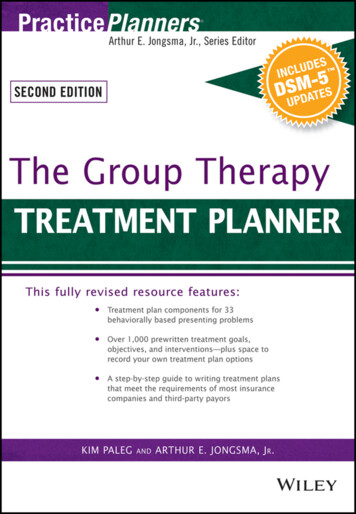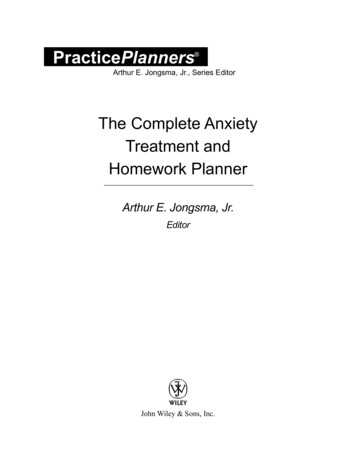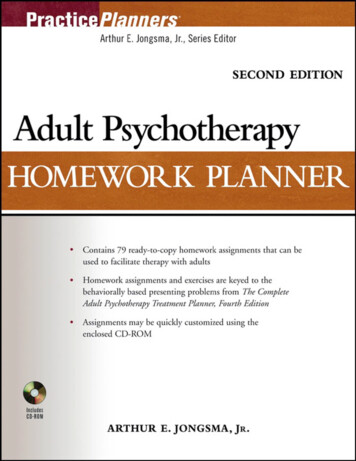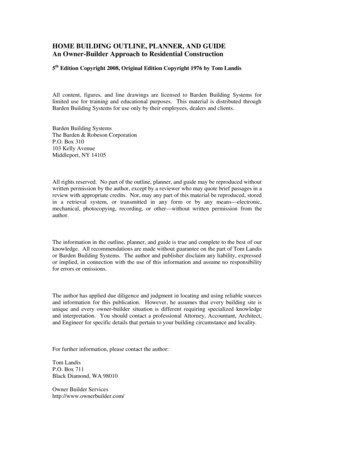
Transcription
The Group TherapyTreatment Planner,with DSM-5 Updates
PracticePlanners Arthur E. Jongsma, Jr., Series EditorThe Group TherapyTreatment Planner,with DSM-5 UpdatesSecond EditionKim PalegArthur E. Jongsma, Jr.
This book is printed on acid-free paper.Copyright 2015 by Kim Paleg and Arthur E. Jongsma, Jr. All rights reserved.Published by John Wiley & Sons, Inc., Hoboken, New Jersey.Published simultaneously in Canada.No part of this publication may be reproduced, stored in a retrieval system, or transmitted in any form orby any means, electronic, mechanical, photocopying, recording, scanning, or otherwise, except aspermitted under Section 107 or 108 of the 1976 United States Copyright Act, without either the priorwritten permission of the Publisher, or authorization through payment of the appropriate per-copy fee tothe Copyright Clearance Center, Inc., 222 Rosewood Drive, Danvers, MA 01923, (978) 750-8400, fax (978)646-8600, or on the web at www.copyright.com. Requests to the Publisher for permission should beaddressed to the Permissions Department, John Wiley & Sons, Inc., 111 River Street, Hoboken, NJ 07030,(201) 748-6011, fax (201) 748-6008.Limit of Liability/Disclaimer of Warranty: While the publisher and author have used their best efforts inpreparing this book, they make no representations or warranties with respect to the accuracy orcompleteness of the contents of this book and specifically disclaim any implied warranties ofmerchantability or fitness for a particular purpose. No warranty may be created or extended by salesrepresentatives or written sales materials. The advice and strategies contained herein may not be suitablefor your situation. You should consult with a professional where appropriate. Neither the publisher norauthor shall be liable for any loss of profit or any other commercial damages, including but not limited tospecial, incidental, consequential, or other damages.This publication is designed to provide accurate and authoritative information in regard to the subjectmatter covered. It is sold with the understanding that the publisher is not engaged in renderingprofessional services. If legal, accounting, medical, psychological or any other expert assistance isrequired, the services of a competent professional person should be sought.Designations used by companies to distinguish their products are often claimed as trademarks. In allinstances where John Wiley & Sons, Inc. is aware of a claim, the product names appear in initial capital orall capital letters. Readers, however, should contact the appropriate companies for more completeinformation regarding trademarks and registration.For general information on our other products and services please contact our Customer CareDepartment within the United States at (800) 762-2974, outside the United States at (317) 572-3993 or fax(317) 572-4002.Wiley also publishes its books in a variety of electronic formats. Some content that appears in print maynot be available in electronic books. For more information about Wiley products, visit our Web site atwww.wiley.com.ISBN 1-119-07318-9 (paper)1-119-07480-0 (ePDF)1-119-07482-7 (ePub)Printed in the United States of America.10987654321
To the clients in groups everywhere who have shared thewealth of their experience and made this book possible.—K.P.To Jim Voetberg, my first group therapy partner whenwe were both just learning to listen, explore, support,confront, teach, and affirm.—A.E.J.
CONTENTSPracticePlanners Series PrefaceAcknowledgmentsIntroductionAdult Children of Alcoholics (ACOA)Anger Control ProblemsAnxietyAssertiveness DeficitAttention-Deficit/Hyperactivity Disorder(ADHD)—AdultBorderline Personality DisorderBulimiaCaregiver BurnoutChemical DependenceChild Molester—Adolescent MaleChronic PainCodependenceDepressionDomestic Violence Offenders—MaleDomestic Violence Survivors—FemaleGrief/LossHIV/AIDSIncest Offenders—Adult MaleIncest Survivors—Adult FemaleInfertilityObsessive-Compulsive Disorder (OCD)Panic/AgoraphobiaParenting 1ix
xCONTENTSPosttraumatic Stress Disorder (PTSD)Rape SurvivorsSeparation/DivorceShynessSingle ParentsStepparentingToxic Parent SurvivorsType A StressVocational Stress221232239248258266275284295Appendix A: Bibliotherapy ReferencesAppendix B: Recovery Model Objectives and Interventions303311
PRACTICEPLANNERS SERIES PREFACEAccountability is an important dimension of the practice ofpsychotherapy. Treatment programs, public agencies, clinics, andpractitioners must justify and document their treatment plans tooutside review entities in order to be reimbursed for services. Thebooks in the PracticePlanners series are designed to help practitionersfulfill these documentation requirements efficiently and professionally.The PracticePlanners series includes a wide array of treatmentplanning books including not only the original Complete AdultPsychotherapy Treatment Planner, Child Psychotherapy TreatmentPlanner, and Adolescent Psychotherapy Treatment Planner, all now intheir fifth editions, but also Treatment Planners targeted to specialtyareas of practice, including: AddictionsCo-occurring disordersBehavioral medicineCollege studentsCouples therapyCrisis counselingEarly childhood educationEmployee assistanceFamily therapyGays and lesbiansGroup therapyJuvenile justice and residential careMental retardation and developmental disabilityNeuropsychologyOlder adultsParenting skillsPastoral counselingPersonality disordersProbation and parolePsychopharmacologyRehabilitation psychologySchool counseling and school social workxi
xiiTHE GROUP THERAPY TREATMENT PLANNER Severe and persistent mental illnessSexual abuse victims and offendersSocial work and human servicesSpecial educationSpeech-language pathologySuicide and homicide risk assessmentVeterans and active military dutyWomen’s issues In addition, there are three branches of companion books that can beused in conjunction with the Treatment Planners, or on their own: Progress Notes Planners provide a menu of progress statementsthat elaborate on the client’s symptom presentation and theprovider’s therapeutic intervention. Each Progress Notes Plannerstatement is directly integrated with the behavioral definitions andtherapeutic interventions from its companion Treatment Planner.Homework Planners include homework assignments designedaround each presenting problem (such as anxiety, depression,substance use, anger control problems, eating disorders, or panicdisorder) that is the focus of a chapter in its correspondingTreatment Planner.Client Education Handout Planners provide brochures and handoutsto help educate and inform clients on presenting problems andmental health issues, as well as life skills techniques. The handoutsare included on CD-ROMs for easy printing from your computerand are ideal for use in waiting rooms, at presentations, asnewsletters, or as information for clients struggling with mentalillness issues. The topics covered by these handouts correspond to thepresenting problems in the Treatment Planners.The series also includes adjunctive books, such as The PsychotherapyDocumentation Primer and The Clinical Documentation Sourcebook,contain forms and resources to aid the clinician in mental healthpractice management.The goal of our series is to provide practitioners with the resourcesthey need in order to provide high-quality care in the era ofaccountability. To put it simply: We seek to help you spend more timeon patients, and less time on paperwork.ARTHUR E. JONGSMA, JR.Grand Rapids, Michigan
ACKNOWLEDGMENTSI am grateful to Art Jongsma for his guidance and feedback; to hisassistant, Jen Byrne, for her uncomplaining approach to thedifficulties incurred by my inability to bring my technological skills upto scratch; and to the scores of colleagues who are doing terrific workwith groups and from whose experience I drew in writing this book.Last but not least, I would like to thank my husband, who patientlyguided me through my introduction to Windows and the electronicage of e-mail, and my children, who put up with late pickups, hastilythrown-together meals on writing days, and Saturday disappearanceswhen writing days did not suffice.—K.P.It has been a privilege to collaborate with such a talented andinsightful coauthor as Kim Paleg. I want to take this opportunity torecognize her wonderful ability to communicate complex proceduresin concise but clear statements—a rare talent. Thank you, Kim, foryour contribution to our Practice Planner series. I know you havegiven many therapists clear direction with best practice techniques forhelping people in need of counsel and support.I also would like to thank the wonderful staff at John Wiley fortheir ongoing support of the Practice Planner series. We areapproaching our tenth anniversary of the series and it has been anexciting and rewarding journey for me and my family. Thank youPeggy, David, Judi, Cris, Micheline, Rich, and Lynne. You are suchcreative people!The encouragement of my wife, Judy, continues to give meenergy to apply to this series as I attempt to keep the material freshand useful to our readers. Thank you, Judy, for being there for overforty years!—A.E.J.xiii
INTRODUCTIONSince the early 1960s, formalized treatment planning has graduallybecome a vital aspect of the health care delivery system, whether it istreatment related to physical health, mental health, child welfare, orsubstance abuse. What started in the medical sector in the 1960s spreadinto the mental health sector in the 1970s as clinics, psychiatrichospitals, agencies, and so on, began to seek accreditation from bodiessuch as the Joint Commission on Accreditation of HealthcareOrganizations (JCAHO) to qualify for third-party reimbursements.With the advent of managed care in the 1980s, treatment planningtook on even more importance. Managed care systems insisted thatclinicians move rapidly from assessment of the problem to theformulation and implementation of the treatment plan. The goal ofmost managed care companies is to expedite the treatment process byprompting the client and treatment provider to focus on identifyingand changing behavioral problems as quickly as possible. Treatmentplans must be specific as to the presenting problems, behaviorallydefined symptoms, treatment goals and objectives and interventions.Treatment plans must be individualized to meet the client’s needs andgoals, and the observable objectives must allow for setting milestonesthat can be used to chart the client’s progress. Pressure from thirdparty payors, accrediting agencies, and other outside parties hastherefore increased the need for clinicians to produce effective, highquality treatment plans in a short time frame. However, many mentalhealth providers have little experience in treatment plan development.Our purpose in writing this book is to clarify, simplify, and acceleratethe treatment planning process.PLANNER FOCUSThe Group Therapy Treatment Planner was conceived as a way tofacilitate the treatment of specific therapeutic problems in the group1
2THE GROUP THERAPY TREATMENT PLANNERsetting. At a time when managed care organizations are becoming thenorm in health care and mental health benefits are being severelyrestricted, there is enormous pressure to treat problems in as costeffective a way as possible. Focal group therapy is an effective, costreducing alternative to individual therapy.Focal groups, in contrast to more traditional transference-basedmodels of group therapy, are characterized by their homogeneity, theirhigh degree of structure, their goal orientation, and their higheducational function. Most are time-limited, though in this TreatmentPlanner the specific length of each group is left up to the individualclinician to determine. Also left up to the individual clinician are theissues of group size and the specific screening procedures she or he willuse in determining eligibility for the group, apart from meeting thebehavioral definitions listed for each specific problem.Because most problems encountered in life are problems ofrelationships with others, from the family to the workplace to socialactivities, dealing with specific problems in the group format allowsclients to work on their issues in the mode that often feels mostfamiliar and comfortable to them. In a group setting, client problemscan be acted out directly, as opposed to symbolically, and thusaddressed more effectively. Furthermore, group members can sharetheir resources and their insights and develop new self-perceptions asthey see themselves interacting in different ways.The Group Therapy Treatment Planner outlines many treatmentissues, the specific goals for treating them, and a range of interventionsfor reaching those goals. It is important to remember, however, thatthis treatment planner cannot substitute for either good clinicaltraining and judgment or experience with groups. Both criteria must bemet in order for the material in this book to be most effectively used.This second edition of The Group Therapy Treatment Plannercontains several significant changes: Five new presenting problem chapters have been included:Attention-Deficit/Hyperactivity Disorder (ADHD)—Adult,Borderline Personality Disorder, Obsessive-Compulsive Disorder,Posttraumatic Stress Disorder (PTSD), and Stepparenting.Refinements to previous treatment plan statements—Each itemfrom the first edition was carefully reviewed to clarify the language, reduce redundancies, and sharpen the focus ofinterventions coordinated with objectives.Improved chapter layout—Interventions are now listed directlyacross the page from the Objectives with which they areassociated.
INTRODUCTION3DEVELOPING A TREATMENT PLANThe process of developing a treatment plan involves a logical series ofsteps that build on each other much like constructing a house. Thefoundation of any effective treatment plan is the data gathered in athorough biopsychosocial assessment. As the client presents himself orherself for treatment, the clinician must sensitively listen to andunderstand what the client struggles with in terms of family-of-originissues, current stressors, emotional status, social network, physicalhealth, coping skills, interpersonal conflicts, self-esteem, and so on.Assessment data may be gathered from a social history, physical exam,clinical interview, psychological testing, or contact with a client’ssignificant others. The integration of the data by the clinician or themultidisciplinary treatment team members is critical for understandingthe client, as is an awareness of the basis of the client’s struggle. Wehave identified six specific steps for developing an effective treatmentplan based on the assessment data.Step One: Problem SelectionAlthough the client may discuss a variety of issues during theassessment, the clinician must ferret out the most significant problemson which to focus the treatment process. Usually a primary problemwill surface, and secondary problems may also be evident. Some otherproblems may have to be set aside as not urgent enough to requiretreatment at this time. An effective treatment plan can deal only with afew selected problems or treatment will lose its direction. This Planneroffers 33 problems from which to select those that most accuratelyrepresent your client’s presenting issues.As the problems to be selected become clear to the clinician or thetreatment team, it is important to include opinions from the client asto his or her prioritization of issues for which help is being sought. Aclient’s motivation to participate in and cooperate with the treatmentprocess depends, to some extent, on the degree to which treatmentaddresses his or her greatest needs.Step Two: Problem DefinitionEach individual client presents with unique nuances as to how aproblem behaviorally reveals itself in his or her life. Therefore, eachproblem that is selected for treatment focus requires a specific definitionabout how it is evidenced in the particular client. The symptom patternshould be associated with diagnostic criteria and codes such as those
4THE GROUP THERAPY TREATMENT PLANNERfound in the Diagnostic and Statistical Manual (DSM) or theInternational Classification of Diseases (ICD). The Planner, followingthe pattern established by DSM-5, offers such behaviorally specificdefinition statements to choose from or to serve as a model for yourown personally crafted statements. You will find several behaviorsymptoms or syndromes listed that may characterize one of the 33presenting problems.Step Three: Goal DevelopmentThe next step in treatment plan development is to set broad goals forthe resolution of the target problem. These statements need not becrafted in measurable terms but can be global, long-term goals thatindicate a desired positive outcome to the treatment procedures. ThePlanner suggests several possible goal statements for each problem, butone statement is all that is required in a treatment plan.Step Four: Objective ConstructionIn contrast to long-term goals, objectives must be stated inbehaviorally measurable language. It must be clear when the client hasachieved the established objectives; therefore, vague, subjectiveobjectives are not acceptable. Review agencies (e.g., JCAHO), HMOs,and managed care organizations insist that psychological treatmentoutcomes be measurable. The objectives presented in this Planner aredesigned to meet this demand for accountability. Numerousalternatives are presented to allow construction of a variety oftreatment plan possibilities for the same presenting problem. Theclinician must exercise professional judgment as to which objectivesare most appropriate for a given client.Each objective should be developed as a step toward attaining thebroad treatment goal. In essence, objectives can be thought of as aseries of steps that, when completed, will result in the achievement ofthe long-term goal. There should be at least two objectives for eachproblem, but the clinician may construct as many as are necessary forgoal achievement. Target attainment dates may be listed for eachobjective. New objectives should be added to the plan as theindividual’s treatment progresses. When all the necessary objectiveshave been achieved, the client should have resolved the target problemsuccessfully.
INTRODUCTION5Step Five: Intervention CreationInterventions are the actions of the clinician designed to help the clientcomplete the objectives. There should be at least one intervention forevery objective. If the client does not accomplish the objective after theinitial intervention, new interventions should be added to the plan.Interventions should be selected on the basis of the client’s needsand the treatment provider’s full therapeutic repertoire. This Plannercontains interventions from a broad range of therapeutic approaches,including cognitive, dynamic, behavioral, pharmacologic, familyoriented, and solution-focused brief therapy. Other interventions maybe written by the provider to reflect his or her own training andexperience. The addition of new problems, definitions, goals,objectives, and interventions to those found in the Planner isencouraged because doing so adds to the database for future referenceand use.Some suggested interventions listed in the Planner refer to specificbooks that can be assigned to the client for adjunctive bibliotherapy.Appendix A contains a full bibliographic reference list of thesematerials. The books are arranged under each problem for which theyare appropriate as assigned reading for clients. When a book is used aspart of an intervention plan, it should be reviewed with the client afterit is read, enhancing the application of the content of the book to thespecific client’s circumstances. For further information about self-helpbooks, mental health professionals may wish to consult TheAuthoritative Guide to Self-Help Books (1994) by Santrock, Minnett,and Campbell (New York: Guilford Press).Assigning an intervention to a specific provider is most relevant ifthe client is being treated by a team in an inpatient, residential, orintensive outpatient setting. Within these settings, personnel other thanthe primary clinician may be responsible for implementing a specificintervention. Review agencies require that the responsible provider’sname be stipulated for every intervention.Step Six: Diagnosis DeterminationThe determination of an appropriate diagnosis is based on anevaluation of the client’s complete clinical presentation. The clinicianmust compare the behavioral, cognitive, emotional, and interpersonalsymptoms that the client presents to the criteria for diagnosis of amental illness condition as described in DSM-5. The issue ofdifferential diagnosis is admittedly a difficult one that has rather lowinter-rater reliability. Psychologists have also been trained to think
6THE GROUP THERAPY TREATMENT PLANNERmore in terms of maladaptive behavior than in disease labels. In spiteof these factors, diagnosis is a reality that exists in the world of mentalhealth care and it is a necessity for third-party reimbursement.(Recently, managed care agencies have shown more interest inbehavioral indices that are exhibited by the client than in the actualdiagnosis.) It is the clinician’s thorough knowledge of DSM-5 criteriaand a complete understanding of the client assessment data thatcontribute to the most reliable, valid diagnosis. An accurate assessmentof behavioral indicators will also contribute to more effectivetreatment planning.HOW TO USE THIS PLANNEROur experience has taught us that learning the skills of effectivetreatment plan writing can be a tedious and difficult process for manyclinicians. It is more stressful to try to develop this expertise whenunder the pressure of increased client load and the short time framesplaced on clinicians today by managed care systems. Thedocumentation demands can be overwhelming when we must movequickly from assessment to treatment plan to progress notes. In theprocess, we must be very specific about how and when objectives canbe achieved, and how progress is exhibited in each client. The GroupTherapy Treatment Planner was developed as a tool to aid clinicians inwriting a treatment plan in a rapid manner that is clear, specific, andhighly individualized according to the following progression:1. Choose one presenting problem (Step One) you have identifiedthrough your assessment process. Locate the correspondingpage number for that problem in the Planner’s table of contents.2. Select two or three of the listed behavioral definitions (StepTwo) and record them in the appropriate section on yourtreatment plan form. Feel free to add your own definingstatement if you determine that your client’s behavioralmanifestation of the identified problem is not listed. (Note thatwhile our design for treatment planning is vertical, it will workequally well on plan forms formatted horizontally.)3. Select a single long-term goal (Step Three) and again write theselection, exactly as it is written in the Planner or in someappropriately modified form, in the corresponding area of yourown treatment form.4. Review the listed objectives for this problem and select the onesthat you judge to be clinically indicated for your client (StepFour). Remember, it is recommended that you select at least
INTRODUCTION7two objectives for each problem. Add a target date or thenumber of sessions allocated for the attainment of eachobjective.5. Choose relevant interventions (Step Five). The Planner offerssuggested interventions related to each objective in theparentheses following the objective statement. But do not limityourself to those interventions. The entire list is eclectic andmay offer options that are more tailored to your theoreticalapproach or preferred way of working with clients. Also, just aswith definitions, goals, and objectives, there is space allowed foryou to enter your own interventions into the Planner. Thisallows you to refer to these entries when you create a planaround this problem in the future. You will have to assignresponsibility to a specific person for implementation of eachintervention if the treatment is being carried out by amultidisciplinary team.6. Several DSM-5 diagnoses are listed at the end of each chapterthat are commonly associated with a client who has thisproblem. These diagnoses are meant to be suggestions forclinical consideration. Select a diagnosis listed or assign a moreappropriate choice from the DSM-5 (Step Six).Note: To accommodate those practitioners who tend to plantreatment in terms of diagnostic labels rather than presentingproblems, Appendix B lists all of the DSM-5 diagnoses that have beenpresented in the various presenting problem chapters as suggestionsfor consideration. Each diagnosis is followed by the presentingproblem that has been associated with that diagnosis. The providermay look up the presenting problems for a selected diagnosis to reviewdefinitions, goals, objectives, and interventions that may beappropriate for their clients with that diagnosis.Congratulations! You should now have a complete, individualizedtreatment plan that is ready for immediate implementation andpresentation to the client. It should resemble the format of the“Sample Treatment Plan” presented on page 8.A FINAL NOTEWe have put together a variety of choices to allow for thousands ofpotential combinations of statements that join to make a completedplan for treatment. Clinicians using their good judgment can easilyselect statements that are appropriate for the individuals they aretreating. Each statement can be modified as necessary to more directly
8THE GROUP THERAPY TREATMENT PLANNERapply to a specific individual client. Finally, we believe from ourexperience that the Planner method of treatment plan construction ishelpful in that it stimulates creative thoughts by clinicians. New ideasfor all components of a treatment plan may come to mind as thePlanner statements are reviewed. Clinicians can add to the Planner bywriting in new definitions, goals, objectives, and interventions.
INTRODUCTION9SAMPLE TREATMENT PLANPROBLEM: ANGER CONTROL PROBLEMSDefinitions: History of explosive aggressive outbursts out ofGoals:proportion to any precipitating stressors.Overreacts with hostility to insignificant irritants.Uses verbally abusive language.Recognizes and admits to negative consequences ofpoor anger control (in terms of relationships, health,work life, etc.).Express anger in a controlled, respectful manner withreasonable judgment regarding time and place.OBJECTIVESINTERVENTIONS1. Keep a log of circumstances 1. Assign the group members tosurrounding the experience ofkeep an anger log to facilitateanger.self-observation. Entriesinclude date, time, thesituation, anger-triggeringthoughts, emotional arousal(on a scale of 1 to 10), andaggressive behavior (on a scaleof 1 to 10).2. Review the members’ angerlogs and have members sharewith the group insights gained.2. Verbalize an understanding1. Teach the group that anger is aof the two-step model oftwo-step process, requiringanger.both (1) experience of pain(physical or emotional), and(2) use of trigger thoughts(attributions that blame othersfor the painful experience) todischarge arousal.2. Facilitate a group discussionabout anger’s self-perpetuatingcycle of anger: anger-triggerthoughts—more anger; encour-
10THE GROUP THERAPY TREATMENT PLANNER3. Verbalize an awareness of the 1.futility of ventilation as ananger-control tool.4. Use imagery to demonstrate 1.the coping skills of relaxationand positive self-talk in lowanger situations.2.5. Verbalize an understandingof active and passiveResponse Choice Rehearsal(RCR).1.age the members to share theirown experiences with this cycle.Elicit the members’ beliefsabout the value of ventinganger; then correctmisperceptions by teachingthat ventilation increases ratherthan dissipates anger.Lead the group through theentire combined relaxationprogram: progressive musclerelaxation (without tension),followed by safe placevisualization, and finally deepabdominal breathing using cuewords; assign them to practicethe entire sequence daily duringthe week and report on theirprogress the following week.Facilitate the groupdevelopment of a list of selftalk statements for eachcategory of trigger thoughtand a list of general copingstatements (“I can stay calmand relaxed,” “Getting madwon’t help”); make copies foreach group member.Teach the group three active(when the client is feelinganger) Response ChoiceRehearsal (RCR) openingstatements (McKay andRogers): (1) ask for what youneed/want (“I’m feeling ,and what I think I need/wantin this situation is .”);(2) negotiate (“What wouldyou propose to solve thisproblem?”); (3) use self-care(“If this continues, I’ll have toin order to take care ofmyself.”).
INTRODUCTION112. Teach the group three passive(when other person is feelinganger) RCR openingstatements (McKay andRogers): (1) get information(“What do you need in thissituation?” “What concernsyou?” “What’s bothering you inthis situation?”); (2) acknowledge (“So what you wantis ;” “So what concerns/bothers you is .”); (3)withdraw (“It feels like we’restarting to get upset;” “I wantto stop and cool off forawhile.”).6. Verbalize own need1. Help each member developstatements, negotiatingappropriate, assertivestatements, and self-careneed/want statements, and selfsolutions assertively, notcare solutions; emphasizeaggressively.positive voice control (e.g., nosarcasm or anger).7. Demonstrate flexible use of1. Assign triads of members tothe six RCR responses inrole play low-, medium-, androle-play situations.high-anger scenes (with oneperson the provocateur, onepracticing the RCR responses,and the third coaching);facilitate group discussionabout role-play experienc
Psychotherapy Treatment Planner, Child Psychotherapy Treatment Planner, and Adolescent Psychotherapy Treatment Planner, all now in their fifth editions, but also Treatment Planners targeted to specialty areas of practice, including: Addictions Co-occurring disorders Behavioral medic











